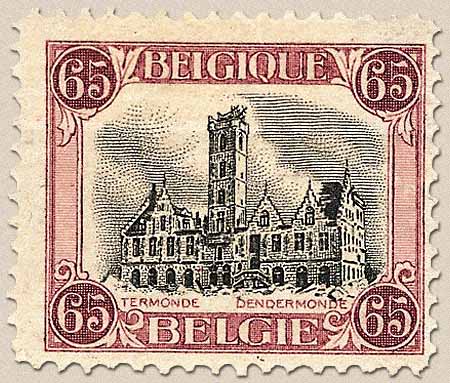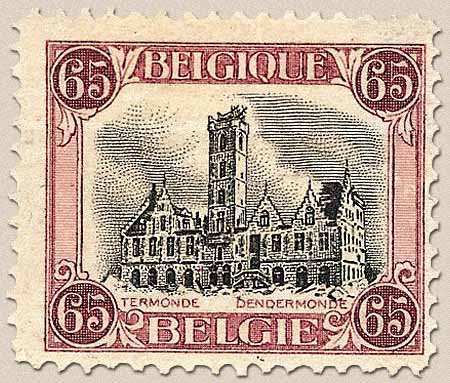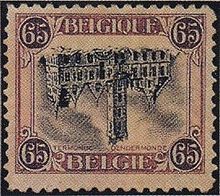| City hall of Dendermonde. |
|
Next |
this item is available in |
|
Date of issue: 5th August of 1920.
OBC/COB numbers: 182-182A
Design by : John Enschede & Zonen
Engraving : John Enschede & Zonen
Perforation : 11 1/2 x 11 1/2
Size:
Composition of the sheets: 1 panels of 25 (5x5)
Printing Process: Deepprint
Number of plates: I
Printing Run: 182 -12.802.500ex including 188
Paper: machine Paper
Watermark : None
182 - 65c - Purple Red (2th print )
Stamp format 261/4 x 221/2 mm
182A - 65c - Purple Red (1st print )
INFO
|
The Most Famous Belgian Stamp : The inverted Dendermonde Background The 65 cent stamp, depicting the townhall of Dendermonde (French : Termonde) was issued on 5 August 1920. It was a completion of a definitive series of stamps printed between 1915 and 1919 which depicted on the lower nominations - 1 cent up to 25 cent - King Albert I and the higher nominations - 35 cent up to 10 Francs - various subjects. InversionTwo sheet of the first run had its centre inverted, so that the depicted town hall is upside down. Most likely the cause of this error was similar to the one of the Inverted Jenny , since the Belgian stamp has also two colours. The first sheet was partially sold in the Post Office of Ghent. After this discovery was made, the management of the Belgian Post went to Enschedé to find out if there were more. A second sheet was discovered, transported to Brussels and destroyed. One pane of the second run was also inverted. 50 copies of these were discovered in January 1921 in Leuven . They were confiscated by the Post Office before they could be sold to the general public. The remaining 50 were still in Holland and were cut, this being witnessed by Dutch and Belgian officials. The 50 already in Belgium were destroyed by burning them on 21 January 1921. Known stamps18 of the 25 stamps were sold at the Post Office of Gent (Fr. Gand) on 13 August 1920. When the discovery was made, only 7 copies remained. ValueThe cancelled stamp is valued at € 100,000 and is one of the most expensive Belgian stamps. Source : Wikipedia |



